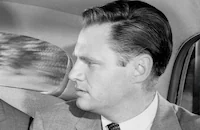Gunfight at Comanche Creek

Brief Synopsis
Cast & Crew
Frank Mcdonald
Audie Murphy
Ben Cooper
Colleen Miller
Deforest Kelley
Jan Merlin
Film Details
Technical Specs

Synopsis
Bob Gifford of the National Detective Agency is assigned to smash a Colorado outlaw gang that operates by breaking wanted men out of jail, forcing them to be the unmasked front men in their holdups, and when the price on their heads grows high, killing them and claiming the reward money. In an effort to learn the identity of the gang's secret leader, Gifford poses as a criminal and is taken into the gang through the usual process and forced to participate in their crimes. Meanwhile, he becomes attracted to Abbie, the owner of the town's hotel-saloon. Another agent, Nielson, is assigned to follow and assist Gifford, but the outlaws eventually discover his camp, and he sacrifices himself to avoid compromising his partner. Carter, a young outlaw who wants to quit the gang and settle down, befriends Gifford and sets out to inform the local marshal of the group's activities. He fails to return, however, and Gifford realizes that the marshal himself is the leader of the gang. As Gifford is about to be killed for the reward, other National Detective Agency men come to his rescue, and, after a raging gun battle, the marshal is arrested.

Director
Frank Mcdonald
Cast

Audie Murphy

Ben Cooper
Colleen Miller
Deforest Kelley

Jan Merlin

John Hubbard
Damian O'flynn
Susan Seaforth

Adam Williams
Mort Mills
John Milford
Michael T. Mikler
Tom Browne Henry

William Wellman Jr.
Laurie Graham
Tim Graham

Eddie Quillan
Crew
Edward Armand
William Austin
Edward Bernds
Joseph Biroc
Ralph Butler
Max Frankel
Marty Greco
Hazel Hall
Edward Jewell
Nellie Manley
Edward Morey Jr.
Ben Schwalb
Marlin Skiles
Clarence Steensen
Don Torpin
James West
Wally Westmore

Film Details
Technical Specs

Articles
Gunfight at Comanche Creek -
All five films contain virtually the same story idea: an outlaw gang bust criminals out of jail and makes them join in for bank robberies, ensuring that the criminals' faces are seen during those robberies; then, when the price on the exposed criminals' heads shoots up, they kill them for the bounty. In Gunfight, Audie Murphy plays the detective who infiltrates the gang to try and stop them.
The film was shot in April 1963 and released that November. Leading lady Colleen Miller recalled: "We shot that very quick--in only days. The film wasn't that good. I think it needed some more script... Audie played the guitar and would sing songs to me--and every other woman who was around."
This was the next-to-last feature film credit for director Frank McDonald, who had made a career in B movies and television. He was under contract to Republic for several years starting in 1939, and later he directed some very low-budgeted films for Paramount, produced by William Pine and William Thomas, known in Hollywood as the "Dollar Bills" for their penny-pinching ways. Starting in 1944, McDonald directed many Roy Rogers Westerns, including Bells of Rosarita (1945) and My Pal Trigger (1946), arguably two of Roy's best. In the 1950s, McDonald turned to television Westerns (including 149 episodes of The Life and Legend of Wyatt Earp starring Hugh O'Brian), while still turning out low-budget features for Monogram and Allied. Those he worked with described him as having a ribald sense of humor, well-dressed and with a constant walking stick.
Reviews of Gunfight at Comanche Creek were perfunctory but not bad. "Devised and executed with journeyman efficiency," said Variety. "Tailor-made to satisfy the tastes of Audie Murphy [fans]." Film Daily declared "it should easily please the Western fan," and The Hollywood Reporter deemed it "a fairly good story with some suspense turns here and there." The review noted that because it was shot in springtime, "the customary dull colors of the brush are enlivened by spring flowers and fresh greens."
Look for DeForest Kelley, later to play "Bones" McCoy in Star Trek, as Amos Troop--one of several western heavies he played at this point of his career.
SOURCES:
Francis M. Nevins, They Called the Shots: Action Directors From Late Silents to the Late Sixties
Bob Larkins and Boyd Magers, The Films of Audie Murphy
By Jeremy Arnold

Gunfight at Comanche Creek -
Quotes
Now, let's go over what we know so far. We're faced with a shrewd and ruthless gang of outlaws. Their operation is clever and deadly. They wait until a man with a price on his head is jailed, then spring him and use him as a front man for a series of holdups...making sure he is the only one ever recognized. The reward keeps going up. When it reaches three or four thousand dollars, the man is killed. Somebody is hired to collect the reward.- Mike O'Brien, Chief National Detective Agency
Trivia
Notes
The working title of this film is The Great Gunfighter.

Miscellaneous Notes
Released in United States 1964
Released in United States 1964














